Economic analysis of Barratt Developments plc
1.0 INTRODUCTION
Barratt Developments plc, a national house builder in the UK construction industry, listed in the FTSE 250, is the second largest house builder in the UK by revenue and by market size (LSE 2010). Like its two biggest competitors, Taylor Wimpey plc and Persimmon plc, it has within the last two years been badly affected by the recession which hit the UK economy in 2008. Before then the company, which was founded in 1958 in Newcastle upon Tyne, had enjoyed relative boom in the UK house building sector, culminating in the acquisition of Wilson Bowden plc in 2007. This acquisition enabled the company to effectively expand its commercial property development arm. As at present, Barratt Developments is represented in all house building sectors in the UK, with Barratt Homes in the residential housing market, David Wilson Homes in the up-scale housing market, Ward Homes (a regional brand operating in Kent and the south-east), and Wilson Bowden Developments in the social housing and commercial property development market. The onset of the recession has however presented unprecedented challenges to Barratt’s operations, causing it to have to rethink strategies and policies in a bid to reduce mounting debts and cope with falling house prices and a drop in sales due to falling demand for new homes.
This is a report which aims to analyse the strategy of Barratt Developments plc, especially as it relates to its response to the current economic situation in the UK. The report seeks to analyse how this company has operated in the past, how it is operating now, and how it intends to operate going forward, with a view to making appropriate recommendations which relate to future strategic choices for the company.
2.0 METHODOLOGY
In order to carry out a proper strategic analysis for Barratt Developments plc, a study wi ll be carried out to give a clear picture of what the background to the current situation is. Using available statistics and graphs that highlight key economic indicators like gross domestic product and unemployment, this report will analyse how prevailing external factors affect Barratt’s position in the market. A PESTLE analysis will be carried out, again with particular emphasis on economic factors, and relevant comparative data will be used to set the proper context within which the strategic analysis will be carried out. The report will then go on to analyse the house building market, using market data such as completions, new start mortgages etc, identifying market segments and highlighting features of the market.
Next, the competitive environment in which Barratt operates will be analysed. Using charts and matrices for comparison the report will focus on Barratt’s biggest competitors in the house building market, with particular emphasis on who the major players are in different market segments, differences in operating methods, U nique S elling P oints and any other indication of competitive advantage. The report will then go on to consider Barratt’s operating methods, using company reports to decipher available resources, product portfolio, staffing, gearing etc. These will then be analysed using theoretical models (e.g. Porter’s five forces and Ansoff’s matrix).
Finally, a SWOT analysis will be carried out using previously cited data and any extra relevant information which can lead to a synthesis of Barratt’s strengths, weaknesses, opportunities and threats. Following this, the report will make conclusions and recommendations which will be based on findings from the SWOT analysis.
3.0 BACKGROUND
A look at company reports for Barratt Developments shows that the company had been doing relatively well up until the current economic recession. This invariably begs the question as to whether there is a direct link between the current economic situation and the current situation of Barratt. Therefore, an analysis of the state of the UK economy and a subsequent comparison of this with the situation in Barratt is necessary.
The Office for National Statistics (2010) puts the official start of the economic recession at the 2nd quarter of 2008. This signalled the first drop of the country’s gross domestic product (GDP) and thus a shrink ing of the economy, after years of growth. This fall in GDP continued quarter after quarter for six consecutive quarters, only rising by 0.4% in the fourth quarter of 2009, which technically marked the end of the recession. The figure below shows a steady growth in GDP from 2004 up until the 2nd quarter of 2008, where a sharp decline is noticed.
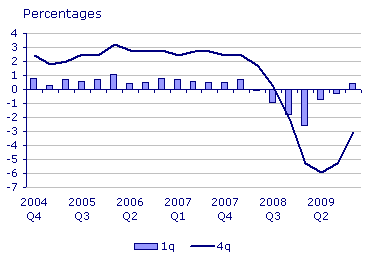
Fig 1: Trends in UK GDP, 2004–2009 (ONS 2010)
This fall in GDP meant that less business was being transacted in the economy than previously carried out, leading to a necessary reduction in the work force in the form of job cuts. The result was an increase in unemployment in most sectors of the economy, particularly the construction and house building sectors. Though compared to previous recessions the percentage rise in unemployment was lower , it was still significant enough to considerably affect the economy negatively. Below are figures showing GDP and unemployment rates and comparisons with previous recessions.
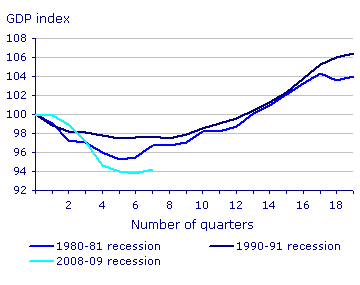
Fig 2: GDP compared to previous recessions (ONS 2010)
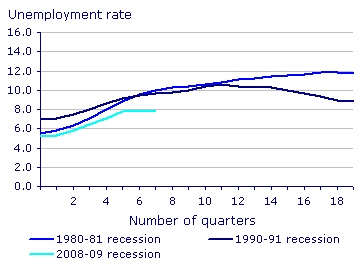
Fig 3: Current unemployment rate, compared to other recessions (ONS)
Balance of trade in the economy continued to run at a deficit, with the deficit increasing between 2008 and 2010. This means the UK has continued to increase its imports and exports have continued to decline. The figure below captures this scenario.
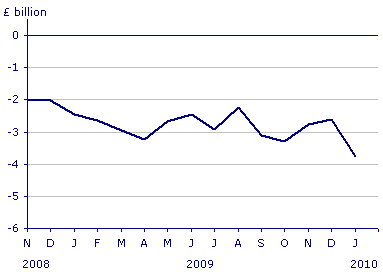
Fig 4: UK Balance of Trade (ONS 2010)
In summary, general indications in the UK economy show that the economy has suffered a massive decline within the last two years. This is more apparent in the quarters covering the period of the recession. The International Monetary Fund statistics for the UK summarise some of these indicators, as shown in the figure below.
4.0 PESTLE ANALYSIS
4.1 Political Factors
Political, economic, social, technological, legal and environmental factors in the UK have in the past determined strategies adopted by Barratt Developments plc and will continue to do so. Political decisions determine economic and regulatory policies which have to be considered in formulating strategy. For example, the government’s Home Owners Mortgage Support Policy Scheme assists home owners who have met certain criteria and are unable to meet their mortgage commitments to pay off their mortgages by providing up to 80% of total interest guaranteed ( Communities and Local G overnment 2010). This policy will in some way determine part of Barratt’s strategy because the more people who can afford mortgages, the more houses developers like Barratt will sell.
4.2 Social and Legal Factors
Social and legal factors also affect the strategies Barratt adopts because change in patterns of living may dictate what type of houses become more in demand (e.g. family style houses as opposed to flats or vice versa), while changing laws and regulations also have to be satisfied in the course of carrying out their core business activity.
4.3 Economic Factors
The main focus here however is on the prevalent economic factors and how Barratt responds to the se in terms of strategy. As shown by the GDP and unemployment figures, the general economic outlook for the past six quarters has been that of a contracting economy. Even with the nominal growth achieved in the seventh quarter (F ig 1), most sectors of the economy are still struggling with the effects of the down turn. The result, coupled with high unemployment rates, is that people have less money to spend, and tend to spend their limited resources on essential commodities. This invariably means that the high end market where Barratt is represented by the David Wilson brand may suffer. However, the government has made efforts to ensure that more credit is available for people through the banks by issuing bailout funds. These measures may yet still be inadequate, as depicted in a recent Financial Times Online article, where Barratt called for banks to increase lending and review current stringent mortgage criteria (FT 2010). These developments also mean that Barratt may have to sell its considerable stock of built houses (see company reports in appendix) at prices far lower than were originally estimated, in order to raise cash and improve liquidity.
5.0 MARKET
The current state of the house building market in some ways reflects the state of the general economy. Statistics from National Statistics Online (2010) show that there has been a marked drop in new orders obtained by contractors in the last two years. New orders for public housing stood at £466m in the 4th quarter of 2008, down from £643m in the same quarter of 2007, while new orders for private housing stood at £1,306m in the 4th quarter of 2008, compared to £2,984m in the 4th quarter of the previous year (see appendix). This slump was expected to continue in 2009 and 2010.
In January of this year, mortgages agreed with first time buyers fell by 49% compared to December figures, and the number of loans for first time buyers fell by 53% to 11,300. Loss of investor confidence in the wholesale debt market has left a funding gap of about £300b for mortgage providers which has been temporarily filled by government funding under special liquidity and credit guarantee schemes. These temporary measures are however expected to expire as from 2011 ( Jamieson 2010). However, the property news service, P roperty W ire (2010), writes that not much has been done by way of new housing in providing specialised retirement housing as only 6% of over 65s in the UK live in specialised retirement homes. This scenario does not look favourable to Barratt; however the short- term infusion of government funding offers some hope.
6.0 COMPETITIVE ENVIRONMENT
In terms of competitors in the UK house building market, Barratt’s (the second largest) major rivals based on sales revenue are Taylor Wimpey, the largest house builders, Persimmon plc, the third largest, and the Berkeley Group. The chart below shows the annual revenue for the four companies for 2009.
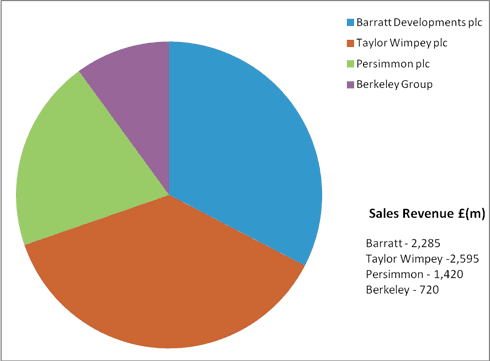
Fig 6: Size of UK’s major house builders, based on sales revenue
In terms of market size, Barratt is also the second largest house builder in the UK, and the chart below shows its market size in comparison to its biggest competitors. The market size is an indication of the approximate number of buyers and sellers in the UK housing market.
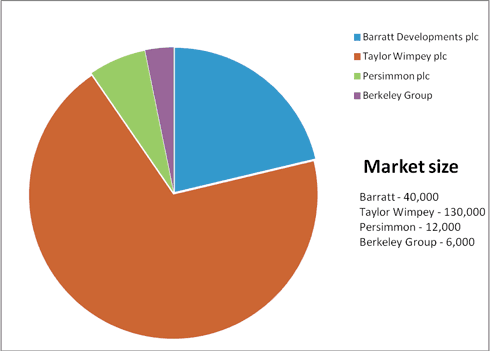
Fig 7: UK’s major house builders based on market size (LSE 2010)
6.1 Unique Selling Points and Competitive Advantage
The competitive nature of the house building market means that firms are constantly looking for new ways to gain competitive advantage over each other. A look at the company profiles of the four house builders (Barratt inclusive) compared in this report show different Unique Selling Points (USPs). Barratt has in the last few years focused on innovation in design in order to gain competitive advantage. This can be seen in its green house designs and electron development in London, which have both won national awards for innovative designs. Taylor Wimpey’s strategy is to focus on sales increase rather than volume growth, by driving costs down and improving quality. Persimmon group are looking to invest more in their Space4 timber frame manufacturing facility, in order to drive sustainability in their buildings. The group believe that manufacturing their own timber frames will give them competitive advantage. Berkeley group pride themselves o n maintaining Britain’s architectural heritage in their designs, and this, combined with a strong focus on community regeneration gives them competitive advantage.
The table below also shows some features of all four companies that give an indication of their competitiveness.
Fig 8: Comparison of special operations
Barratt | Taylor Wimpey | Persimmon | Berkeley | |
Foreign Operations | No | Yes | No | No |
Part Exchange | Yes | Yes | Yes | Yes |
Loans | Yes | Yes | Yes | No |
7.0 PRODUCT PORTFOLIO, GEARING AND DEBT
In terms of product portfolio, Barratt is involved with almost all types of product in the housing market. This has worked as an advantage so far, as it seems to be able to switch product focus according to demand. It also seems to be stronger in some specific areas than some of its competitors, for example in the construction of green buildings. The chart below shows Barratt’s product portfolio.
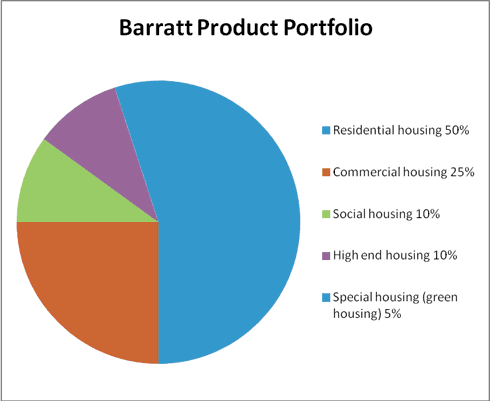
Fig 9: Barratt Product Portfolio
7.1 Gearing
From company reports (see appendix), Barratt is a low geared firm as the total equity of the company contributes more to its available capital than long-term borrowings. Considering the depressed market this is a good position for the company to be in and should be maintained.
7.2 Debt
Barratt has made a loss in the last two years (see company reports in appendix) and has been struggling with mounting debt. However, Inside Housing (2009) reports that a recent rights issue by Barratt has been seen to be a success, raising about £720m and reducing its debt from about £1,422m to about £700m. This has given a major boost to the company and has it looking at developing new sites. This rights issue strategy is now being copied by several competitors who are looking to raise extra cash as well.
8.0 MODEL ANALYSIS
8.1 Five Forces Model
Based on Porter’s five forces model, the market forces affecting Barratt Developments and its position with respect to this are shown by the model below.
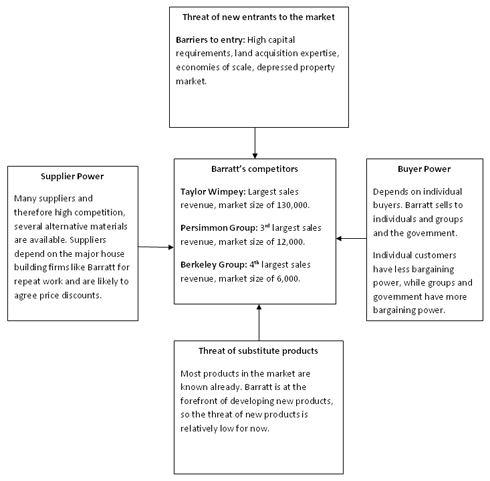
Fig 10: Barratt’s Market Position (based on Porter’s five forces model)
Due to high barriers to entry into the market and the general economic situation which has limited the bargaining power of suppliers the company is in a reasonably good position. However the same economic situation has limited demand and so increased buyer power.
8.2 Ansoff’s Matrix
Using Ansoff’s matrix, Barratt’s strategic position in terms of its product portfolio can also be plotted. The matrix below shows Barratt’s options.
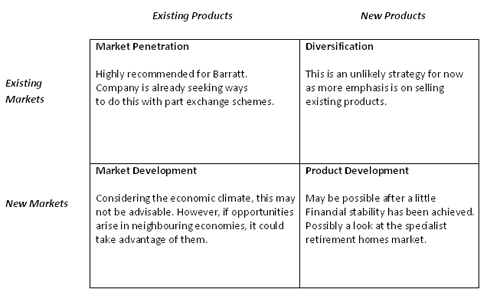
9.0 SWOT ANALYSIS
9.1 Strengths (internal positive factors)
- These will include Barratt’s diverse product portfolio which allows it to switch products with demand.
- The board of Barratt consists of five executive and five non executive members from diverse backgrounds. This enables them to achieve a balance in terms of formulating strategy.
- Barratt’s leading role in innovative house building technology is an advantage.
- The recent rights issue has injected badly needed cash into the company and gives it an advantage also.
- Awards won by Barratt give it a better brand image as a company dedicated to quality.
9.2 Weaknesses (internal negative factors)
- Lack of adequate finance and debt is a continual setback to the survival of the company.
- Timing of merger with the Wilson Bowden brand has affected Barratt negatively in terms of finance within the last few years.
- Despite being one of the bigger brands in the UK, Barratt still has a low international profile, unlike some of its competitors.
- Unsold stock of houses is still a problem as it ties up much needed cash.
9.3 Opportunities (external positive factors)
- Advancement in technology and emphasis on sustainability means that Barratt can take advantage of its innovativeness to gain competitive advantage.
- The underdeveloped nature of the specialised retirement home market means that Barratt can expand to that market.
- The economic forecasts show that the recession has technically come to an end. Barratt can position itself to take advantage of the recovering economy when it fully sets in.
9.4 Threats (external negative factors)
- Government plans to cut spending in future could hamper Barratt’s ability to reach full recovery.
- While it still tries to return to profitability, some of Barratt’s competitors are already profitable. This could pose challenges to Barratt’s progress.
- The reluctance of funding agencies to provide mortgages and loans may slow market demand and therefore slow Barratt’s recovery process.
- Consumer confidence in the market may not return to pre recession levels long after the recession reverses.
10.0 CONCLUSIONS AND RECOMMENDATIONS
10.1 Conclusions
From the all the above analysis, it becomes obvious that Barratt’s first priority is to survive the harsh economic situation, ride out the recession and then get back to profitability. The company has good structures with which this can be achieved and stringent spending measures together with shrewd management decisions (such as the rights issue) can ensure its short-term survival while placing it in a good position for planning long-term strategy.
10.2 Recommendations
Cash obtained from the recent rights issue should be used to pursue further opportunities, such as providing more help in terms of loans to customers. More ways should be sought to get in more resources, as these resources will be vital in overcoming the company’s weaknesses. Weaknesses such as unsold housing stock need to be overcome and some of the available resources should be dedicated to bringing in more resources.
REFERENCES
Barratt Development plc (2010) Consolidated Income Statement for the Year Ended June 2009 [online] available from
<http://www.barrattdevelopments.co.uk> [30 March 2010].
Berkeley Group (2010) Consolidated Income Statement for the Year Ended April 2009 [online] available from
<http://www.berkeleygroup.co.uk> [30 March 2010].
Communities and Local Government (2010) Homeowners Mortgage Support – Policy Scheme Description [online] available from
<http://www.communities.gov.uk/housing/buyingselling/mortgagesupportscheme/
mortgagesupportpolicy> [07 April 2010].
Financial Times (2010) UK House Builders [online] available from
<http://www.ft.com/cms> [07 April 2010].
International Monetary Fund (2009) Report for Selected Countries and Subjects [online] available from
<http://www.imf.org/external/pubs/ft/weo/2009/> [30 March 2010].
Jamieson, B. (2010) ‘Renewed worries for UK housing market as mortgage funding dries up’. SCOTLANDonSUNDAY 14 March [online] available from
< http://scotlandonsunday.scotsman.com/sos-
business-columnists> [07 April 2010].
LSE (2010) Share Price Information for Major UK House Builders [online] available from
< http://www.lse.co.uk/SharePrice.asp?shareprice> [06 April 2010].
Office for National Statistics (2010) UK Economy: GDP and Unemployment in the Recession [online] available from
<http://www.statistics.gov.uk> [01 April 2010].
Persimmon plc (2010) Consolidated Income Statement for the Year Ended December 2009 [online] available from
<http://production.investis.com/psn/investor/presentations> [31 March 2010].
Property Wire (2010) ‘Booming Retiree Segment Represents Untapped Opportunity In UK Real Estate’. NuWire Investor 5 March [online] available from
< http://www.nuwireinvestor.com/articles> [31 March 2010].
Taylor Wimpey plc (2010) Consolidated Income Statement for the Year Ended December 2009 [online] available from
<http://www.barrattdevelopments.co.uk/ir/reports> [31 March 2010].